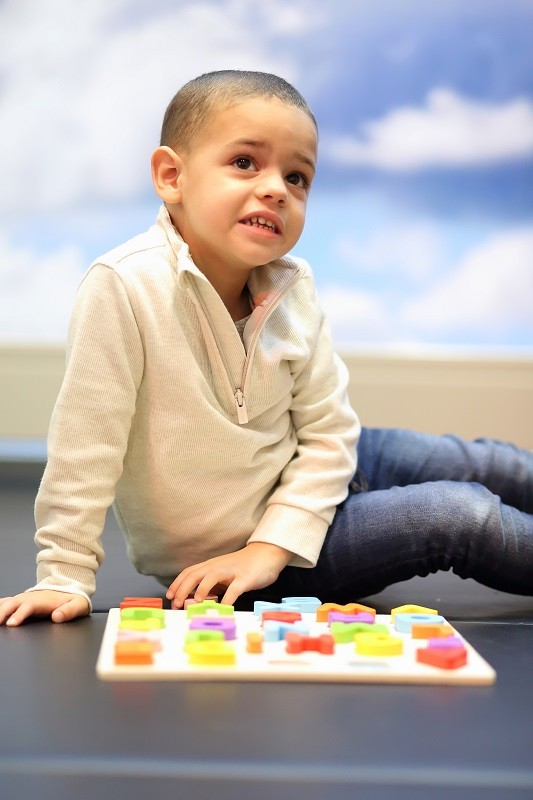 Before Chandler, age 3, started speech and occupational therapy at CentraState’s OceanFirst Rehabilitation Center, he spoke very little and communicated primarily with pointing, despite having early intervention services. After months of intensive therapy, this now-talkative child has found his voice.
Before Chandler, age 3, started speech and occupational therapy at CentraState’s OceanFirst Rehabilitation Center, he spoke very little and communicated primarily with pointing, despite having early intervention services. After months of intensive therapy, this now-talkative child has found his voice.
Chandler suffered from recurring ear infections that made hearing, and therefore verbal communication, difficult.
“He used to get very frustrated because he knew what he wanted to say; he just couldn’t get the words out,” says Tiara, Chandler’s mother. “He is so much happier now that he can express himself.”
Chandler had bilateral ear tube surgery with Gregory Smith, MD, an ear, nose, and throat doctor at CentraState, which relieved him of the constant infections and fluid buildup. He then began speech therapy with Sarah Elzayat, MS, CCC-SLP, TSSLD, a speech-language pathologist at CentraState.
His first session set him on the right path to begin building his vocabulary and facilitating speech production to express his wants and needs.
Combined with simultaneous occupational therapy with Alexandra Goldstein, OTR/L, Chandler works weekly on speech production and verbal communication, as well as sensory processing and gross and fine motor skills.
A Collaborative Approach
During therapy sessions, Sarah and Alexandra work together to develop fun, purposeful, and functional activities for Chandler. They’ve incorporated obstacle courses, games, and puzzles into sessions. Occupational therapy helps Chandler increase his awareness, attention, and sensory processing of the environment around him, which then helps to drive his speech production. It also provides him with tools to stay focused and deal with distractions—skills that come in handy for school and everyday life.
“We work on day-to-day functional skills while communicating what we are doing, like taking off our shoes or opening the door,” says Alexandra. “In this instance, occupational therapy and speech therapy go hand-in-hand.”
As part of speech therapy, Chandler is encouraged to repeat his therapists’ words while they play. Every activity is verbalized to help him associate certain words or phrases with their meanings. The therapists have Chandler ask for turns, request new activities, share what he wants to do, and let them know of any sensory needs he wants to be fulfilled.
“It sounds like we are narrating and repeating ourselves,” adds Sarah. “It’s important that Chandler is surrounded by an abundance of language to build these associations quickly. He now knows that if he says what he needs, he then gets it.”
This remarkable progress can be attributed to Chandler starting therapy so young—and so quickly. Sarah and Alexandra encourage other parents to seek an evaluation if they feel their child is experiencing any delay.
“The earlier the intervention for a child, the better the outcome,” says Sarah. “Therapy is a tool and a resource to help.”
Adds Alexandra, “That little push provides children with the extra help they need to feel comfortable in their own skin and achieve their dreams.”
A Life with Language
Chandler continues to progress and learn new words every day. With the help of Sarah and Alexandra, his parents continue therapies at home by verbalizing with their son all day while staying attuned to his sensory needs. Chandler’s family has become passionate advocates for him throughout his journey.
“Together, Sarah and Alexandra have brought Chandler from saying nothing to speaking three-word sentences,” says Tiara. “They’ve given him the voice that I was waiting forever to hear.”
For more information about pediatric rehabilitation services at CentraState, visit centrastate.com/pediatricrehab or call 866-CENTRA7 (866-236-8727).





